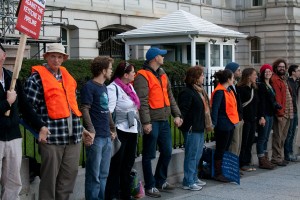Protesters swarmed Lafayette Park in the nation’s capital to rally together before forming a human chain of more than 12,000 outside the White House in Washington, D.C., to protest the Keystone XL Pipeline on Sunday.

The Keystone XL pipeline is a pipeline proposed by TransCanada, a Calgary-based energy company, that will carry oil sands, or tar sands, from Alberta, Canada, to refineries in Texas.
Opponents of the pipeline argue oil sands are one of the dirtiest forms of fuel and have the potential to harm the environment and pollute water sources. Proponents argue that Canada is a more politically stable oil producer than countries in the Middle East or elsewhere.
The federal government is expected to announce its plans for the pipeline by the end of the year.
Protesters crowded the park and wore orange “No Frack” vests and carried signs that read, “Our terms for a 2nd term no pipeline” and “NOKXL,” or “No Keystone XL.”
The Occupy Washington, D.C., protesters showed their support of the NOKXL protesters by leaving their ‘Occupy’ camp in the capital’s McPherson Park to bolster the numbers at the White House.
The protest was held exactly one year before the next presidential election in an effort to remind Obama of what he had promised his predominantly young, environmentally conscious constituency.
The November protest was much more successful, having a significantly larger turnout than the two previous protests in August and September where several of the protestors had been arrested. The November protest had more than 10,000 more participants than the previous two protests.
Maura Stephens, adviser of Frack Off and associate director of the Park Center for Independent Media, said there is an array of protest movements going on currently that are all affiliated.
“It’s an important opportunity for people who are speaking out on so many issues right now,” Stephens said.
At the rally, several people spoke against the Pipeline including Rep. Steve Cohen, (D-TN); Dr. James Hansen, the scientist that brought climate change to the government’s attention in the 1980’s; and Tom Poor Bear, the vice president of the Oglala Lakota Nation.
The speakers excited the crowd and lead them to chant phrases like “Hey, Obama, the Earth is your mama,” “We are people too,” “This is what democracy looks like” and “Yes, we can stop the pipeline.”
The speakers discussed how they believed the economy must be reinvented and that this was the turning point for the nation to decrease its dependence on “dirty” foreign oil. They called for protesters to write letters to Obama and demand action for cleaner energy sources.
The protesters broke into three randomly selected color groups — red, brown and orange — in order to make it easier to organize them into line. Once the groups organized, they encircled the White House, held hands and chanted.
A State Department report issued in August said if TransCanada performs all proposed environmental protections, the pipeline’s construction would pose “no significant impacts” on the environment. The report acknowledged the possibility of a potential oil spill despite the protections.
Cornell senior K.C. Alvey, a member of the State Focal Point with Green Umbrella, a network of young activists within the state of New York, said the protesters were trying to hold the president accountable as a leader in sustainability.
“We’re calling on President Obama this weekend not only to say no to the pipelines, but also to be a leader in developing clean energy,” Alvey said.
Junior Max Grigri, co-president of IC Frack Off and the Central New York regional coordinator for Green Umbrella, said he was pleased with the protest’s turnout and the crowd’s energy.
“The job isn’t done, there is still more to be done,” Grigri said. “But it’s a step closer.”







